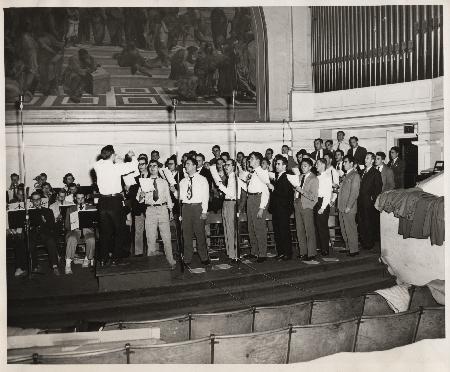
- Virginia Glee Club recording with the University Band, 1947 (courtesy UVA Visual History archives)
I’ve devoted some of my Virginia Glee Club historical research time to non-Glee Club topics in an effort to better understand the life of the average Club guy across the decades of the group’s existence. In the process, I’ve learned some interesting things about Club itself.
First, other musical groups, namely the University Band. If you think the Club has had a checkered history, what with multiple potential founding dates and occasional fallow years, then check out the band! Though instrumental music has an earlier start date than organized glee clubs, with the first reference to student instrumental groups coming in 1832, there were not only many starts and stops but also outright faculty opposition. In a foreshadowing of this year’s performance space flap, students were forbidden in the late 1830s from practicing instruments except between the hours of 2 and 3 in the afternoon, or from four to eight o’clock at night—and never on Sunday. So formal bands died out, to be replaced by the Calathumps — not a good tradeoff for order at the University. New organized bands sprouted in the early 20th century but seemed always to die away, so you had a founding of a band in 1908–09, another in 1910–11, another in the 1920s, another in 1934, a dwindling to almost nothing in the early 1960s, and then a resurgence with significant donor money in 2004. The last refounding of the Band, with the clear goal of the extinguishing of the Pep Band, doesn’t reflect well on student self governance, but at least it got a band that had instruments and practice space.
Second, the Arcadians. I’ve written about them before, but it’s interesting to study this group in a little more detail. The University had had a small dramatic group, the VVV Club, in the early 1900s, but the Arcadians were something else—seriously organized, putting on big shows, and apparently sucking in all the musical talent. In 1904 the University only had 662 students, not reaching over 1000 until 1915–16, and the pool of available students wasn’t big enough to support both a Glee Club and a dramatic group that performed musicals. So, after five musicals, the Arcadians were bankrupt and no student groups remained to put on entertainments. Enter the Glee Club of 1910–11. And, given that there were only a few additional fallow years from this season forward, we can really thank the poor financial management skills of the Arcadians with giving the Glee Club the opportunity to get back on its feet for good.
